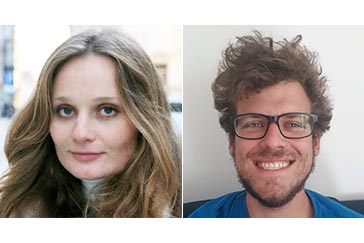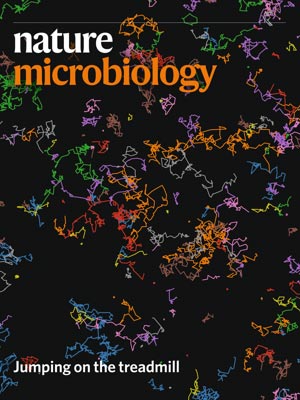March 5, 2020
Little cell – big cover story
IST Austria scientists rebuild cell division machinery to reveal protein choreography – Study featured on the cover of Nature Microbiology

Biologists from the Institute of Science and Technology (IST Austria) have answered a long-standing question in bacterial physiology by rebuilding parts of the cell division machinery: When a bacterium, which is a single cell, divides into two identical daughter cells, its surrounding cell wall has to be remodeled and constrict inwards. How is this remodeling achieved in a highly controlled manner? Their study was published as the cover story of the March 2020 issue of Nature Microbiology.
The remodeling of the cell wall during the cell division process is believed to be coordinated by some 20 different proteins that are organized into the division machinery, amongst them the bacterial tubulin FtsZ. To look into the function of FtsZ, postdoc Natalia Baranova and PhD student Philipp Radler from the group of Professor Martin Loose at IST Austria rebuilt part of the division machinery from bottom-up and revealed the mechanistic details on how FtsZ filaments regulate the distribution of cell wall synthesis enzymes to support smooth and robust cell constriction. A detailed description of the mechanism of bacterial cell division is of utmost importance, e.g. for the development of new antibiotics.
Natalia Baranova, first author of the study with a PhD in biophysics from the Center of Cooperative Research in Biomaterials (CIC biomaGUNE), Spain, about her approach: “I rebuild biological assemblies from well-defined building blocks. Most of my reconstitutions include multiple components that can affect each other, collectively self-organize or self-assemble. It creates enormous complexity space for me as an experimentalist, but what I enjoy most is navigating through this complexity. I can tune every component in the system and gain mechanistic information about those biological processes which are difficult to quantify in living cells.”
Philipp Radler, who joined the Loose group in 2017 after graduating in molecular biology from the University of Salzburg, adds: “The idea of breaking down highly complex molecular machines like the divisome—a protein complex in bacteria responsible for cell division—into its constituent parts and precisely describing their molecular interactions is captivating. With this work, we are taking a step forward in the understanding of this complex process.”
What do we see in the cover image?
Natalia explains: “We studied the behavior of single molecules of the cell division machinery diffusing in an artificial cell membrane. We imaged these single molecules by fluorescence microscopy and tracked their behavior using automated tracking software. What you can see on the cover are trajectories of peptides and proteins—individual FtsN peptides transiently interacting with FtsZ filaments.”

© Springer Nature; image: Natalia Baranova & Martin Loose – IST Austria, cover design: Valentina Monaco
In a blog post for the Nature Research Microbiology Community, Natalia describes in more detail how she and her colleagues from IST Austria as well as the UK and Spain examined the bacterial cell division machinery.
Publication
Natalia Baranova, Philipp Radler, Víctor M. Hernández-Rocamora, Carlos Alfonso, Mar López-Pelegrín, Germán Rivas, Waldemar Vollmer & Martin Loose. 2020. Diffusion and capture permits dynamic coupling between treadmilling FtsZ filaments and cell division proteins. Nature Microbiology. DOI: 10.1038/s41564-019-0657-5
Funding Information
The IST Austria part of this work was supported by the European Research Council through grant ERC-2015-StG-679239 to Martin Loose and grants HFSP LT 000824/2016-L4 and EMBO ALTF 1163-2015 to Natalia Baranova.



